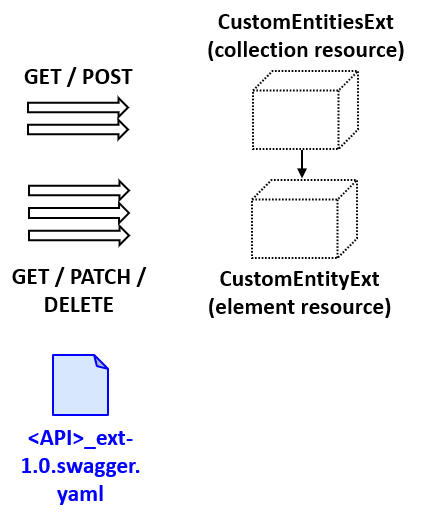Configuring the swagger file for generated endpoints
Within the context of Cloud API, a swagger file defines the endpoints and operations for a given API.

The following sections provide an overview of configuring swagger files for generated endpoints. For a complete description of how to configure swagger files, see Configuring schemas.
Overview of swagger file syntax
A swagger file contains a paths section that lists one or more endpoint
paths. For each path, the following information is specified:
- Any path or query parameters
- Each operation supported for the path, and information about the operation
Modifications made to the swagger file
The base configuration includes a set of API-specific extension swagger files. The
purpose of these files is to define swagger information for custom resources for a given
API. These files are named using the pattern
<API>_ext-1.0.swagger.json, where <API> is the internal name
of the API. For example, the common_ext-1.0.swagger.json file is used
to define swagger information for custom resources in the Common API.
When you generate endpoints for a custom entity, the REST endpoint generator adds code to the corresponding swagger extension file.
For example, suppose you generate endpoints for a
CustomEntity_Ext custom entity. The parent of this entity is Claim,
and the endpoints are placed in the Claim API. The REST endpoint generator add the
following code to the claim_ext-1.0.swagger.json file:
paths:
"/claims/{claimId}/custom-entities-ext":
parameters:
- $ref: "#/parameters/claimId"
get:
summary: "Retrieve a collection of custom entities ext"
description: "Retrieve a collection of custom entities ext"
operationId: getCustomEntitiesExt
x-gw-extensions:
childResourceType: CustomEntityExt
operationType: get-collection
resourceType: CustomEntitiesExt
x-gw-parameter-sets: get-collection
responses:
"200":
description: "Successful response"
schema:
$ref: "#/definitions/CustomEntityExtList"
post:
summary: "Create a new custom entity ext"
description: "Create a new custom entity ext"
operationId: createCustomEntityExt
x-gw-extensions:
childResourceType: CustomEntityExt
operationType: post-collection
resourceType: CustomEntitiesExt
parameters:
- name: body
in: body
required: true
schema:
$ref: "#/definitions/CustomEntityExtRequest"
x-gw-parameter-sets: post-collection
responses:
"201":
description: "The details of the newly-created CustomEntityExt"
schema:
$ref: "#/definitions/CustomEntityExtResponse"
"/claims/{claimId}/custom-entities-ext/{customEntityExtId}":
parameters:
- $ref: "#/parameters/claimId"
- $ref: "#/parameters/customEntityExtId"
get:
summary: "Retrieve details of a custom entity ext"
description: "Retrieve details of a custom entity ext"
operationId: getCustomEntityExt
x-gw-extensions:
operationType: get-element
resourceType: CustomEntityExt
x-gw-parameter-sets: get-element
responses:
"200":
description: "Successful response"
schema:
$ref: "#/definitions/CustomEntityExtResponse"
patch:
summary: "Update a custom entity ext"
description: "Update a custom entity ext"
operationId: updateCustomEntityExt
x-gw-extensions:
operationType: patch-element
resourceType: CustomEntityExt
parameters:
- name: body
in: body
required: true
schema:
$ref: "#/definitions/CustomEntityExtRequest"
x-gw-parameter-sets: patch-element
responses:
"200":
description: "Successful response"
schema:
$ref: "#/definitions/CustomEntityExtResponse"
delete:
summary: "Delete a custom entity ext"
description: "Delete a custom entity ext"
operationId: deleteCustomEntityExt
x-gw-extensions:
operationType: delete-element
resourceType: CustomEntityExt
x-gw-parameter-sets: delete-element
responses:
"204":
description: "Successful deletion"Note that this text is functionally complete and there are no "TODO RestEndpointGenerator" comments in the file. However, a developer may wish to optionally modify the file.
Modifying API documentation text
Every path and response has summary and description
information. This text is used by API definition display tools, such as Swagger UI.
Developers may wish to modify the summary and
description values created by the REST endpoint generator to
improve the user experience for other developers who are consuming these
endpoints.
Removing operations
The REST endpoint generator always generates a collection endpoint with a GET and POST operation, and an element endpoint with a GET, PATCH, and DELETE operation. If you do not want any of these operations, you can remove them from the swagger file.
For example, suppose an insurer wants endpoints to supportCustomEntity_Ext, but they do not want to expose
the ability to delete CustomEntity_Ext instances. In this case, the developer
could remove the "delete" declaration from the swagger file.